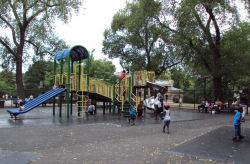Brower Park
Brower Park
What was here before?
This park is part of northern Crown Heights, which was originally inhabited by the Lenape. Dutch settlers arrived in the late 1600s, followed by the English. The area was later part of the extensive Lefferts family property, much of which was auctioned off in 1854. By the end of the 19th century, Crown Heights was an upper-middle class neighborhood of German, Irish, Swedish, and other European immigrants. There was also a significant African American population centered around Weeksville, one of the largest and earliest free Black communities in the United States, on the eastern edge of the neighborhood. By the end of the 1960s, the population of Crown Heights was largely African American, with a substantial Caribbean community that is still prominent today.
How did this site become a park?
The City of Brooklyn purchased the southern portion of the park in 1892. Rolling terrain, dense shrubs, robust native trees, curving walks, and an iron ornamental fence contributed to the beauty of what was then called Bedford Park. An elegant, classically-inspired public restroom was erected in 1905, and a World War I memorial was dedicated in 1919. A parcel to the north of the park was acquired in 1923.
In 1936, the paths were reconfigured and drinking fountains, benches, and a playground were added. Additional parkland was purchased in 1947, the George V. Brower School (P.S. 289) opened in 1958, and Prospect Place was closed between Brooklyn and Kingston Avenues, uniting the north and south portions of the park in 1968.
With the assistance of the Friends of Brower Park, the community built a Monarch Butterfly Garden in 2014 and in 2016 dedicated Shirley Chisholm Circle. The paved, circular terrace along Kingston Avenue was named after Shirley Anita St. Hill Chisholm (1924–2005), educator, social rights advocate, and US Congresswoman. It features a commemorative stone with plaque alongside a tree planted in her honor, as well as benches and planters. New skate park elements were added in 2016, the park’s basketball courts were rebuilt in 2019, and pathways were partially rebuilt in 2022.
The park is also home to the Brooklyn Children’s Museum, which opened in 1899. The institution was the first of its kind. The old museum buildings were replaced in 1977 with a playful building designed by the architectural firm of Hardy Holzman Pfeiffer, which also included rooftop gardens and amphitheater that integrated the museum’s architecture with the park’s landscape. In 2008 a two-story building clad in yellow ceramic tiles designed by Rafael Vinoly doubled the museum’s space and is the first “green” museum in New York City.
Who is this park named for?
In 1923, the Board of Aldermen renamed the park for Brooklyn Parks Commissioner George V. Brower (c. 1839-1921). Although he was born in Paterson, New Jersey, Brower was a member of an old Brooklyn family. He served as an apprentice to a Pennsylvania judge and moved to Brooklyn in 1867 to practice law. Brower was General Appraiser of the Port of New York from 1880 to 1884, and he was a Parks Commissioner from 1889 to 1894 and from 1898 to 1901. He was instrumental in acquiring Red Hook, Fort Hamilton, and Sunset Parks in Brooklyn and “Brooklyn Forest,” now Forest Park in Queens. Brower died in his home, at 1084 Park Place directly south of the park, in 1921.
Check out your park's Vital Signs
Clean & Safe
Green & Resilient
Empowered & Engaged Users
Share your feedback or learn more about how this park is part of a
Vital Park System




